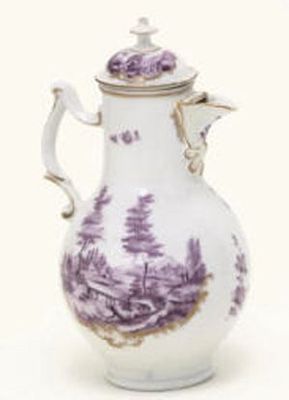

PERIOD: XVIIIeme
A VOLKSTEDT BALUSTER COFFEE-POT AND COVER CIRCA 1775, UNDERGLAZE BLUE PITCHFORK MARK TO INTERIOR OF COVER AND BASE OF TEAPOT With a long neck and wishbone-shaped handle, the body painted in puce cama?eu with figures before buildings and a bridge in wooded river and mountain landscape vignettes, above gilt rocaille ornament and scattered flower-sprays, the cover similarly decorated with lesser landscape vignettes below a knop finial, within gilt line rims (restored chipping to rim of cover, restoration to spout and palmette decoration below, wear and retouching to gilding, area of wear to puce enamels, areas of associated retouching to gilding) 7? in. (18.4 cm.) high The history of Volkstedt porcelain dates to 1760 in Thuringia, Germany, when an entrepreneur by the name of Georg Heinrich Macheleid approached the Prince of Schwarzburg-Rudolstadt. Macheleid requested the exclusive privilege to build a porcelain factory within his principality. The prince, Johann Friedrich, agreed to Macheleid's request with one condition: his exclusive right to produce porcelain in the principality would be maintained so long as no one else in the region was able to verifiably produce a superior product. In exchange, the deal assured Macheleid's factory a constant supply of firewood, tax exemption for four years, low jurisdiction for the factory, religious freedom, and the right to produce all the food the factory would need within its own grounds. Essentially, the porcelain factory quickly became self-sustaining, a village unto itself. In addition, all the materials needed to produce the porcelain could be obtained from nearby regions. These included sand from Rudostaldt, Kapselton-a special type of clay used by the factory-from Coburg, and porcelain mass and glaze from Sitzendorf. While the early years were difficult for the Volkstedt porcelain factory, by the late 18th century the company was producing a high volume of merchandise that earned it renown throughout Europe. The Volkstedt factory produced everything from porcelain dinnerware, vases, candlesticks, basins, boxes, and of course, figurines. A catalogue of 1795 claimed to offer 90 different types of figurines. By the mid-nineteenth century, the Volkstedt factory began producing the famous lace figurines. Also known as "Dresden lace," the effect was accomplished when real cotton lace was dipped in soft paste porcelain and then fired. The fabric burned away, leaving a fragile porcelain "lace" shell that, though delicate, could withstand the test of time given proper care. A number of fine examples of these porcelain lace products, including the famous Volkstedt lace ballerinas, can be found among our collection.
PRIX: $2000